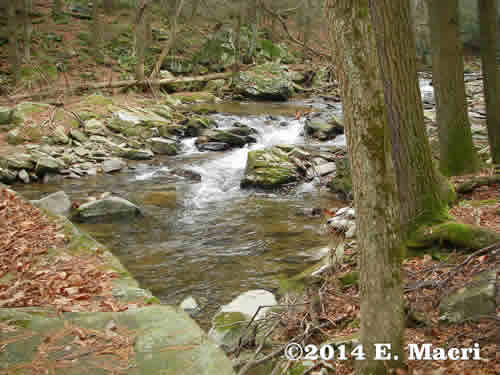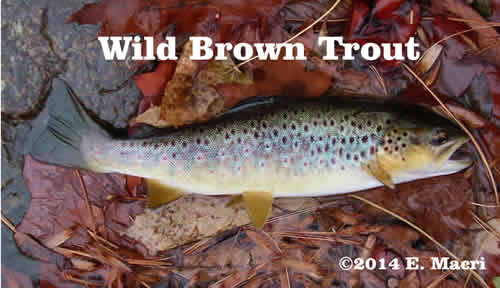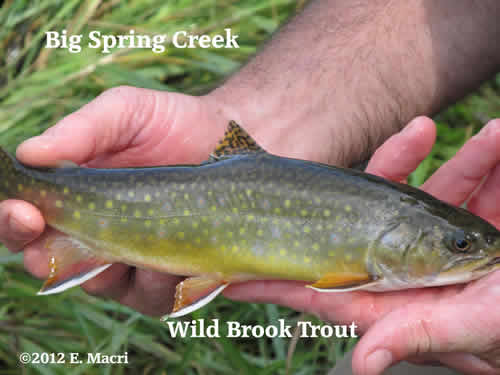How to Manage a Trout Stream
An Introduction
by
Eugene P. Macri Jr.

This is
the question of the milenium--managing a trout stream. The problem is everyone thinks they know how to do
it. Every fisherman, politician, biologist, environmental scientist, and especially fishermen.
State agencies like the Pennsylvania Fish and Boat Commission surely don't! They have a track record of lies,
destruction of their own streams and failure to protect even their best waters. Furthermore, their own
hatcheries destroyed and damaged many of their streams, and they lied to the public about it for over twenty
five years! Other state agencies are bad too when they stocked brook trout over native species and now
have a mess on their hands especially the Western states.
Once again
the main problem is that little science is being used to manage the streams. The resources aren't being
protected. In the state of Pennsylvania license sales are what drives everything. The problem is that too
many of the license sales are based on the production of hatchery trout. The Cult of the Hatchery as it is
often called is what runs the system. There is nothing wrong with hatcheries and hatchery fish. They
are part of the economic system of the state. However, when your hatcheries trump the protection of your
waters as it does in Pennsylvania and some other states you get an unsustainable system. It is impossible for
Pennsylvania and other states to raise enough fish to satisfy the "put and take" hatchery mentality of fishermen
who chase the hatchery truck. It is so bad in Pennsylvania that recent House Hearings of Fish and Game
Committee showed that the delegates wanted to raise fish at any cost including the destruction of the two percent
of the wild streams. In fact, they want no more streams classified as exceptional value because of the
"environmental regulations" gave these streams more protection and allowed less
degradation!
Large flow
through hatcheries which grow trout produce massive quantities of wastes (organic and inorganic). When
these are released into streams they cause great degradation and enrichment of the environment including massive
biogeochemical changes, destruction of macroinvertebrate communities, damaged substrates and erosion of trout
habitat. The cost of systems which treat such perturbations before the effluent enters the stream is
massive and is one of the limiting factors in the production of the fish. There are a number
of ways around this including producing some trout with recirculation technology and stocking trout as
fingerlings. Such programs are used in Michigan and Montana. It takes a tremendous amount of energy to
produce a twelve inch trout and a great amount of money. In fact, you don't have to be math major to realize if
it costs at least $3.00 to make a 12 inch trout not including transportation and you sell 859,000 or so
licenses of which 700,000 are trout fisherman---how many trout much you produce to satisfy the demand hatchery
truck chasers? What if each anglers wants to keep only 10 fish per year? That's 7 million trout! At
$3.00 per trout you get $21 million dollars!!!!!!
I've
simplified this but you can see this isn't going to work. In most waters in Pennsylvania you
can keep 5 trout a day during the season. You will never satisfy the demand. Of course, there is a
percentage of fishermen who practise catch and release or only keep a few but that is easily offset by the numbers
that want to keep just about everything. In Pennsylvania the number of trout stamps purchased in 2013 was
498,000. If each angler decided to keep 10 trout during the year, the total would still be
4.98 million fish. The state only produces around 3.2 million and even if you add the fish from
Pennsylvania's Cooperative Nurseries around 700,000 (estimate) you still can't make it.
This type
of fishery for trout is unsustainable. That's why other states have basically gotten out of the hatchery trout
business in favor of stocking mostly fingerlings and designating restricted keep streams and catch and
release. The 12 inch hatchery trout doesn't seem to work economically does it? However, it can work out
economically and that is if the trout is caught let's say 4 or 5 times because the fish is thrown back, that is
catch and release. In this situation that 12 inch trout furnishes a lot of money to the state and local
area. How? In the form of anglers who fish for it spend money on equipment, transportation,
lodging, food, and entertainment. I know of a few fly fishing zones which have mostly stocked fish and they
furnish a great deal of money at many levels and layers because the fish is returned to the stream. The
Yellow Breeches Creek in Boiling Springs Pennsylvania comes to mind. The fly zone of just over a 1 mile
is a massive draw to say the least and an economic boon to the area and the state.

One of the
major problems with state or federal agencies managing streams is that they try to manage all the waters in the
same way. The wide brush approach is destined to failure. Often times they try and manage wild streams
just like their put and take streams. This is due to political pressure, and the license sales based only on
people who chase hatchery trucks. Designating streams types due to the biogeochemistry and what type trout and
fishing they support would be a start. Try managing for the resource rather than the license sales.
You'll go broke you say! Not quite, you will attract a steady number of anglers who are sportsmen
rather than fishing slobs, your numbers and the amount of money spent to the license sales will stabilize and
you will have an economically sustainable fishery. If you don't, you'll get what we have now in
Pennsylvania and few other states- an unsustainable system based on the "Cult of the
Hatchery."
I have no
problem with anglers keeping trout especially in marginal streams where they probably wouldn't make it through the
summer. However, in Pennsylvania and some other states the entire system is being run for this put and take
fishing. Anglers who want quality fishing bring a tremendous amount of money into the state versus the guy
that only fishes for the stocking truck! If you must saturate your waters with hatchery trout to attract anglers at
the cost of your best resources than your model is worthless.
Trout
streams should be managed for their own resources. In other words, one game plan can't be employed on
marginal streams, wild streams and everything in between. A stream of wild trout with a stable population
doesn't need to be stocked. Limit the number of fish that can be taken from these wild streams. But we
seldom do that in Pennsylvania. That violates someone's rights when fishing! Fishing is a privilege not
a right, that's why you buy a license. There are groups in Pennsylvania that want no
restrictions. That's right! They want to keep everything they catch...no creel
limit.
During a
the so called Save the Brook Trout Campaign in the East which was all the rage a few years ago I attended many
meetings from a number of states. I was trying to get people to agree that these small feeder streams that
contain wild remnant populations of brookies sometimes as few as 30 or 40 fish should be off limits to fishing
and or keeping the fish. The reason for this is that these fish grow slowly in these sparse streams and if you keep
the largest trout which may be only a 9 incher you are destroying the gene pool. My idea was met
with consternation because many thought that if they buy a license they should be able to fish and keep the
fish! Let the streams lie fallow.....a method that some English River keepers use to employ to allow fish
populations to recover but to no avail. This type of lunacy is why most states end up doing policy rather
than science and this is why they are in trouble when it comes to trout stream management. The last group of
people who should have input into how fisheries and streams are managed are the fishermen. Why? For the
most part they don't care about the resource and never will. And those that do care are called
extremists!

A wild
trout is too beautiful and in most cases has tremendous economic value to be caught only once. States like Montana,
Michigan and others are starting to realize this and the amount of money that people are willing to pay for a
chance to catch such trout is way more than people who chase a hatchery truck. Supposedly we've been trying
to "educate" the angler to this but in states like Pennsylvania we have done the exact opposite. The 1895 Cowboy
Mentality of environmental raping is still with us. In fact, in Pennsylvania it may have gotten
worse.
There is
no simple solution to trout stream management whether the streams are public or private. However, by
protecting and managing for the resource you protect the stream and fishery long term. Manage for a quick
buck and hatchery truck chasers and you get the fisheries that are economically, socially and environmentally
unsustainable like Pennsylvania has!
| 
